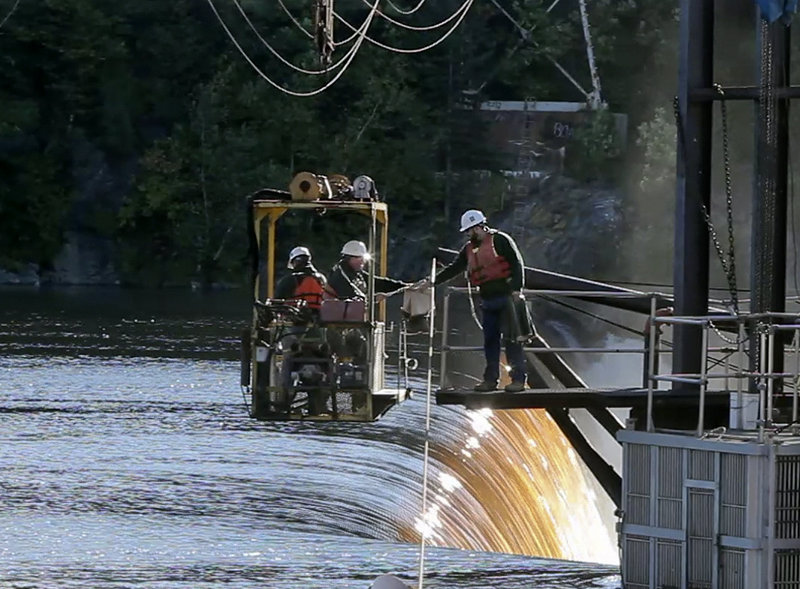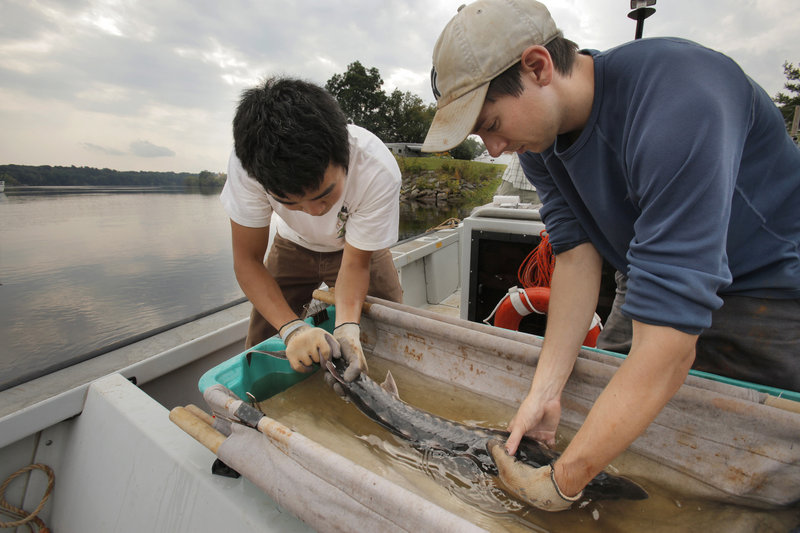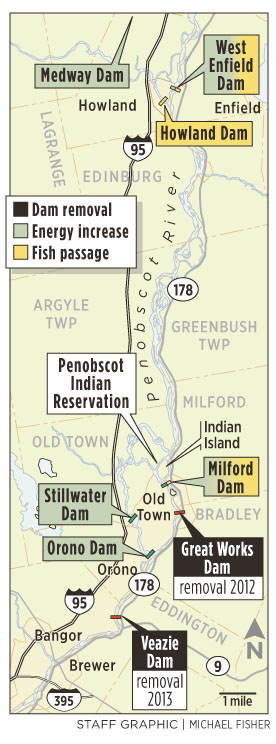GREENBUSH – Ian Kiraly gently nudges the bow of an alien-like vessel along the banks of the Penobscot River. The electro boat, with its cathode tentacles dangling in the water, delivers 600-800 volts of electric current, stunning any fish in the “shock zone,” an 8-foot-deep 100-square-foot area.
Two of his assistants scoop up immobilized fish and drop them in a holding tank in the center of the boat. Kiraly tallies them — chain pickerel, smallmouth bass, fallfish, white sucker, common shiner minnow — before releasing them.
It’s a typical catch here, 11 miles north of Orono and upstream of the three dams that stand between this part of the river and the ocean.
Since he began the study in the spring of 2010 as part of his graduate work at the University of Maine, Kiraly hasn’t caught any shad, alewives, blueback herring or striped bass in this area.
That could change by the spring of 2014, after two of the dams are removed and a state-of-the-art fish lift is installed at the third.
“I’m really curious about what happens when the dams come out, for sure,” he says.
So are a lot of other people.
The river restoration effort is among the most ambitious and complex ever attempted. And already, it’s apparent that it could have an impact on rivers far from Maine.
MODEL FOR COOPERATION
The amount of scientific work now being done on Maine’s largest river is unprecedented.
The research eventually will be used to evaluate dam removal options elsewhere, said Charlie Baeder, who is coordinating the research for the Penobscot River Restoration Trust.
No similar research was done before the removal of the Edwards Dam on the Kennebec River in 1999. As a result, he said, it’s difficult to document the effect the dam’s removal had on the environment.
In another respect, the restoration project is widely viewed as a model for how environmentalists, hydropower companies, native tribes, and state and federal agencies can benefit when they reach agreements that cover an entire river system, rather than fighting one another one dam at a time, said Jeff Opperman, a senior adviser on sustainable hydropower for The Nature Conservancy.
A groundbreaking agreement reached in 2004 allowed the Penobscot River Restoration Trust to buy three dams from the PPL Corp. and plan to remove two of them: Veazie and Great Works.
State fisheries managers are already taking steps in anticipation of the removals — thousands of juvenile alewives have been released in ponds upstream from the dams.
The alewives will swim downstream through existing passages in the dams and spend the next few years in the ocean. In five years, when the females make the more difficult trip up the Penobscot River to spawn, the dams will be gone.
Yet, while the public focus is on dam removal, the project is also an example of how to properly build new hydroelectric dams, Opperman said.
Developing nations around the world are aggressively building dams to produce energy for their growing populations, and environmental groups have little power stop them, Opperman said. The Penobscot restoration project shows that it’s possible to build dams and preserve sea-run fish access to rivers.
When he works abroad in Mexico, Colombia and Costa Rica, Opperman often points to the Penobscot River as an example of both failure and success.
HUGE DECLINES IN SEA-RUN FISH
When the river’s dams were built in the 1800s, Opperman said, the builders never thought about balancing energy production and habitat by taking a view of the entire river basin. As a result, the river has experienced massive declines in populations of sea-run fish such as salmon.
In the early 1800s, about 100,000 salmon, 6 million alewives and 2 million shad annually swam from the sea into the Penobscot to spawn, according to state estimates.
So far this year, just over 3,000 salmon have returned. Spawning shad and alewives number fewer than 1,000 each.
Now, Maine is getting a second chance to do it right, Opperman said.
The Great Works Dam in Old Town will be removed next year, and the Veazie Dam, upstream of Bangor, will be removed in 2013.
In exchange, federal regulators will allow six other dams in the Penobscot watershed to increase power generation, thus maintaining hydropower production at about current levels.
Three of the dams are on river channels outside the Penobscot’s main stem. Two dams will get significantly improved fish passages: an elevator to lift fish over the Milford Dam and a fish bypass at the Howland Dam. The West Enfield Dam has a modern ladder.
The project will improve access to nearly 1,000 miles of historic river habitat for endangered Atlantic salmon and other species of native sea-run fish, such as alewives and shad.
“The lesson here is that there was more than one way to get a certain energy objective,” Opperman said. “The first way results in a dramatic loss of migratory fish habitat. The second way has much less impact on fish.”
For the former owner of the hydroelectric dams, PPL Corp., the agreement put an end to legal battles with environmental groups and the Penobscot Nation over whether federal regulators should continue licensing the dams.
In 2009, Blackbear Hydro Partners LLC purchased those PPL dams in the Penobscot watershed that hadn’t been sold to the Penobscot River Restoration Trust.
Scott Hall, a former PPL official and now an executive with Blackbear Hydro Partners, said the deal gave the dam owners certainty over future federal regulation and allowed them to make investments.
“From our standpoint, the agreement provides the best of both worlds — clean and renewable hydro energy and restored runs of fish,” he said.
DOCUMENTING CONDITIONS
On the river, Kiraly’s electric fishing project is part of an effort to document today’s conditions and enable scientists to determine how the river changes once the dams are removed, including the movement and composition of fish populations, the shape and geological character of the river, water quality, marine nutrients and wetlands.
About $1.3 million is being spent on the largest study ever done in the United States of a river basin before dams are removed, said Baeder, with the Penobscot River Restoration Trust.
Already, the research is paying off.
Few believed that many sturgeon lived in the Penobscot, but researchers who have been tagging the fish since 2006 have found that about 600 live below the first dam, in Veazie.
In winter, the endangered fish gather in a large group downstream from the Bangor Waste Water Treatment Plant.
The prehistoric-looking sturgeon are covered with bony plates and grow to more than 3 feet long. Researchers have found that the fish travel to the ocean to reach other rivers, particularly the Kennebec River, said Matthew Altenritter, who is studying the species for his doctoral thesis at the University of Maine.
He said it appears that sturgeon prefer to spawn in the Kennebec River, perhaps because they can swim farther upstream to where the water is less influenced by tides and less salty.
The dam removals and fish passage improvements will allow sturgeon to migrate farther upstream in the Penobscot, said Kevin Lachapelle, a graduate student at the University of Maine who is working on the sturgeon study.
“We hope it will restore the spawning habitat,” he said.
MaineToday Media State House Writer Tom Bell can be contacted at 791-6369 or at:
tbell@mainetoday.com
Send questions/comments to the editors.





Success. Please wait for the page to reload. If the page does not reload within 5 seconds, please refresh the page.
Enter your email and password to access comments.
Hi, to comment on stories you must . This profile is in addition to your subscription and website login.
Already have a commenting profile? .
Invalid username/password.
Please check your email to confirm and complete your registration.
Only subscribers are eligible to post comments. Please subscribe or login first for digital access. Here’s why.
Use the form below to reset your password. When you've submitted your account email, we will send an email with a reset code.